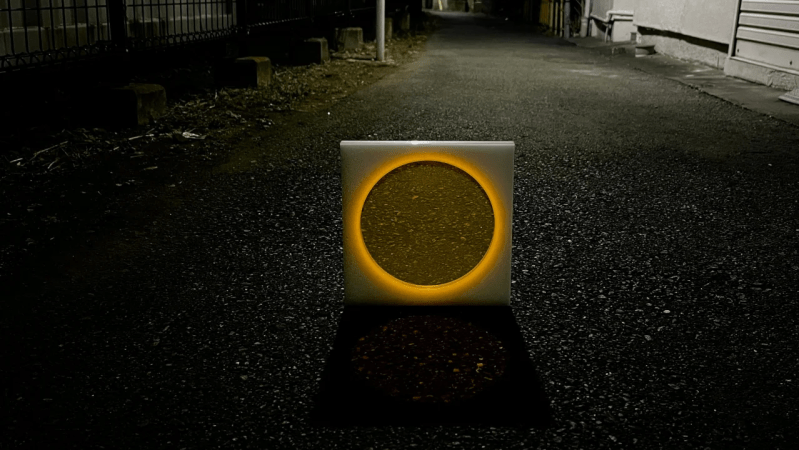[Yuichiro Morimoto] wanted to create a decorative lamp, one that wasn’t burdened with batteries or wires, but used just the ambient light in the room to create a directed glow effect. Using a coloured circular acrylic sheet, with a special coating (not specified) ambient light impinging on the surface is diffused toward the edge. This centre sheet is embedded in an opalescent sheet, which scatters the light from the center sheet, giving a pleasant glow, kind of akin to a solar corona. An additional diffuser cover sheet on the front covers over the edge to hide it, and further enhance the glow effect.
Details of the ‘special coating’ are scarce, with the coloured sheet described as a condenser plate. This clearly isn’t the same as diffuser plastic, as that cannot be seen through as clearly as some of the photographs show. So we’re a little stumped on this one! Please answer in the comments if you can, ahem, shed some light on this one!
When talking about ambient light, many people will think more along the lines of active lighting, for example, adaptive ambient light around a TV like this hack.
Thanks to [Roman] for the tip!
















The key words you are looking for are ‘light-gathering’ or ‘live-edged’ arcylic no special coatings.
Discription from https://www.instituteofmaking.org.uk/materials-library/material/live-edge-perspex
“This material is described as ‘live-edged’ because the edges of the material glow under ambient light as if it has its own internal light source. It is also known as a ‘light-gathering’ acrylic because the live edge is a result of the extruded sheet gathering light from all over its surface, which is then refracted internally and emitted wherever it has been cut. In this case, the laser-cut edges glow, but you can also see some glow from a scratched area in the middle of the sample, and if you were to purposefully engrave the surface of this material, it would also glow. The polymer contains fluorescent dyes to accentuate this effect, so the light emitted gets stronger under UV light and weaker if you place it flat on the table and slowly cover the surface with your hand.”
The acrylic has been commercially available for years now as “Perspex Fluorescent”.
Yeah, it’s fun stuff. Comes in orange (as per post), yellow, blue, pink etc and the green is awesome.
Here’s little plane I laser cut ages ago: https://www.dropbox.com/s/vhnyzcgzhk7qwsr/2016-04-15%2015.37.28.jpg?dl=0. Lights up great with UV.
(Saw this lamp on the design blogs, still wondering what the deal is.)
Nice work!
You can also see the green version in this old project on Hackaday:
https://hackaday.com/2012/03/14/poking-machine/
At around 1:00 in the video you can clearly see the glowing edges as we laser cut the sheets.
So this is just a perspex circle encased in white acrylic with its edges sandwiched? Artist is selling his for $243 (eq. Yen), which is not too crazy for all the material used.
$243 is not too crazy for “art”. Fluorescent acrylic is about twice the price of white (white, black & clear are the cheapest), but there’s only about $10 of plastic there. It is a nice effect though.
I’ve a couple full sheets of that orange, didn’t much care for it. I should see what the green & pink look like behind white (probably opal), wonder if I can get $243 for them too.
Random listing showing pink & green: https://www.lsblog.xyz/ProductDetail.aspx?iid=204857871 with good lighting to get the best effect.
The blue is interesting, appears almost clear: https://www.dropbox.com/s/l7la7znw2vs4ri6/2016-06-03%2009.04.26.jpg?dl=0
Remember Sony Mavica? Used ambient light for screen backlite?
Maybe the fluorescent sights on my Glock are made of the same material.
This is practically the same thing, I believe:
https://amzn.to/3HXIac3
Why not linking the autor’s page?
https://morimoto.studio.site/projects/nisshoku
He is straightforward on how he made the object: saw the panel, liked the effect, made some experiment (shown). I belive the pictures are photoshopped to increase the effect, but I’d love to see it in real life.
Thanks for that! What a simple but cool design.
Not only that, it mentions a critical difference from what the HAD copy erroneously claims.
Artists site: “glows when you shine a black light on it”
HAD: “used just the ambient light in the room”
An acrylic sheet that can directionally gather and redirect ambient light would be a pretty startling development. An acrylic sheet that glows under backlight is a commodity material.
This is quite disappointing and reduces significantly the wow effect
I assumed there was a UV light hiding somewhere.
It’s a cool idea that deserves more experimentation! Kudos!
Cool! I think I understand how this was made, but I wonder if the effect would be better with a 45 degrees cut that better convoys the light towards the front of the device.